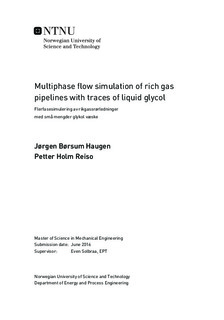Multiphase flow simulation of rich gas pipelines with traces of liquid glycol - Flerfasesimulering av rikgassrørledninger med små mengder glykol væske
Master thesis
Permanent lenke
http://hdl.handle.net/11250/2401213Utgivelsesdato
2016Metadata
Vis full innførselSamlinger
Sammendrag
Long distance transport of multiphase flow is an important technology in the development ofoil and gas fields. Predicting phase behaviour in long pipelines is a demanding and complicated process. To realistically simulate these situations, the industry is reliant on software that can calculate accurate fluid properties. The most used simulation tool today, is a computer program named OLGA (OiL and GAs simulator). OLGA requires input in the form of a fluid property table to conduct these simulations. These property tables are generated by tools like PVTsim (Pressure, Volume and Temperature simulator) and NeqSim (Non-Equilibrium Simulator). The purpose of this Master s thesis was to further develop and improve NeqSim as a fluid property table generator. This taskwas specifically aimed towards liquid viscosity and interfacial tensions of aqueous TEG (TriEthylene Glycol). These properties are regarded among the most influential parameters for fluid behaviour.
Experimental work was conducted to measure the interfacial tensions of high pressure aqueousTEG and methane. There is low availability of such data in the literature. The measurementmethod utilized was the pendant drop method. The interfacial tensions were measured withan uncertainty of less than 2%. Relevant experimental data for liquid viscosities and interfacial tensions were also collected.
The measured data and the collected experimental data were compared to calculated valuesfrom NeqSim and PVTsim. These tools utilize similar empirical methods to calculate liquidviscosities. Interfacial tensions are calculated by the Firoozabadi Ramey Method in PVTsim.NeqSim offers several calculation methods for interfacial tension. These include the Firoozabadi Ramey Method, the Parachor Method, Linear Gradient Theory, Gradient Theory Simpleand Gradient Theory. NeqSim proved to predict the most accurate liquid viscosity values. Inregard to interfacial tensions, Gradient Theory in NeqSim provided the most accurate results.
A parameter study was conducted in OLGA to establish how liquid viscosity and interfacial tensions affects the simulations of multiphase flow. The simulations were conducted using field data provided by Statoil of the Åsgard transport pipeline. The simulations were conducted using both the standard OLGA module and the OLGA HD module. It was shown that alterations in liquid viscosity and interfacial tensions have small impacts on the simulations. Increasing the mass flow of TEG did impact the simulations. The impact was negligible with the standard OLGA module, but significant with the OLGA HD module. It is concluded that the OLGA HD module results in more accurate simulations of the Åsgard transport pipeline. It is also concluded that both NeqSimand PVTsim calculates sufficiently accurate property values to be used in the current OLGA version 7.3.5.
The development of NeqSim as a property generator is a continuous process. There are stillareas where NeqSim can be improved. These are discussed in the final chapter, and includefurther improvements in the calculations of liquid viscosity and interfacial tension and the generation of wax property tables.
